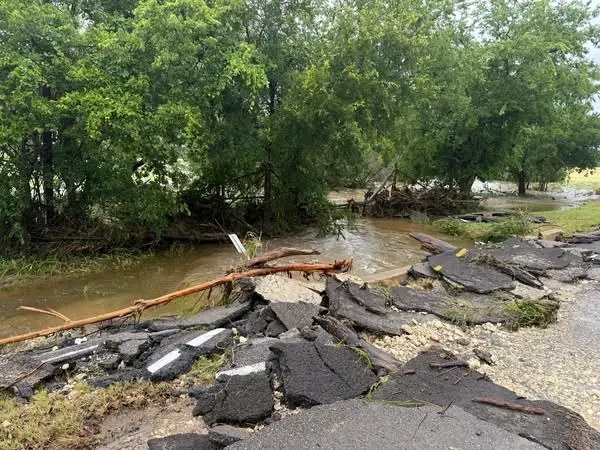Flash Flood Catastrophe in Central Texas: Communities Devastated as Lives Lost, Dozens Missing, and Widespread Destruction Reported
Central Texas – A heartbreaking natural disaster has struck the heart of Texas, leaving communities in shock, families desperate for answers, and entire neighborhoods under water. In what is now being called one of the most severe flash flood events in recent memory, powerful and fast-moving floodwaters tore through Travis and Williamson counties on July 4, sweeping through cities including Austin, Georgetown, and Liberty Hill.
By the evening of July 5, officials confirmed that at least three lives had been lost, and twelve individuals remained unaccounted for. The disaster left entire streets submerged, bridges collapsed, and homes gutted. It has plunged a region into mourning, uncertainty, and a collective effort to search, recover, and rebuild.
The Flood Event: Sudden and Unforgiving
The flooding began with little warning. Overnight on July 3 into the early hours of Independence Day, the region experienced a historic deluge, with rainfall totals in some areas surpassing 12 inches in less than 10 hours. What began as heavy thunderstorms rapidly escalated into a life-threatening event as creeks and rivers swelled beyond capacity, overtopping banks and consuming roads, cars, and homes in their path.
Emergency alerts lit up phones across the area, warning residents to seek higher ground immediately. But for many, especially in lower-lying and river-adjacent communities, there was little time to react.
In Georgetown, floodwaters surged through residential streets, sweeping away vehicles and trapping people inside their homes. In Liberty Hill, the San Gabriel River expanded wildly beyond its normal boundary, transforming quiet rural roads into raging currents. Austin saw several major roadways completely submerged, with emergency services forced to suspend rescue operations in some areas due to the sheer danger posed by the conditions.
Tragedy Strikes: Lives Lost, Families in Mourning
Among the most devastating outcomes of this catastrophe is the loss of life. As of Saturday evening, officials confirmed three deaths related to the flooding. The victims, whose names are being withheld until families are notified, included individuals believed to have been trapped in their vehicles or swept away while attempting to escape rising waters.
Local authorities have expressed their deepest condolences and vowed to support grieving families. Flags have been lowered across multiple public buildings, and moments of silence are being observed across the region as communities come to terms with the magnitude of the tragedy.
Search and rescue crews, including swift-water specialists, K9 units, and National Guard members, continue to work around the clock to locate the twelve individuals still reported missing. Their families wait in anguish, some gathered in community centers set up as reunification sites, clinging to hope.
Damage Across the Region
The structural and environmental toll of the floods is staggering. In Austin, Lady Bird Lake overflowed into surrounding parklands, and multiple trails and bridges were destroyed. Sections of Interstate 35 and Highway 183 were closed due to washouts and debris fields. Liberty Hill reported more than 70 homes damaged or destroyed, and entire subdivisions remain without electricity or clean water.
In Georgetown, dozens of families have been displaced, with some neighborhoods completely inaccessible due to collapsed bridges and impassable roads. Local officials estimate damages in the tens of millions, though a full assessment will take weeks, if not longer.
Emergency shelters have been opened in churches, schools, and recreation centers. Volunteers, nonprofits, and first responders have mobilized quickly, providing food, clothing, medical care, and emotional support to evacuees and those affected.
Eyewitness Accounts: “Like Nothing We’ve Ever Seen”
Survivors and witnesses described scenes of chaos and heartbreak. One woman, evacuated from her Liberty Hill home by boat, wept as she recalled seeing her neighbors’ home float off its foundation. “It happened so fast,” she said. “We didn’t even have time to pack. We grabbed the dog, our phones, and prayed.”
In Georgetown, a young man helped rescue an elderly couple trapped in their SUV by tying a rope to a nearby tree and wading through waist-deep water. “I couldn’t just leave them there,” he said. “The current was pulling hard. But I had to try.”
First responders also spoke of the emotional weight of the situation. Many have been working non-stop for more than 36 hours. “We’ve had to make incredibly difficult calls,” one firefighter shared. “There are places we just can’t get to yet.”
Rescue and Relief Efforts
The response to the catastrophe has been rapid and widespread. Governor’s Office officials confirmed the deployment of the Texas National Guard and coordination with FEMA to support rescue operations and initiate disaster relief.
Over 100 swift water rescue teams have been deployed across Travis and Williamson counties, pulling stranded residents from rooftops, attics, and flooded vehicles. Helicopters and drones are assisting in search operations in hard-to-reach areas.
Local governments have opened emergency assistance hotlines and established resource hubs where residents can access recovery services, apply for temporary housing, and receive updates on missing persons. Volunteer organizations like the Red Cross, Texas Baptist Men, and Feeding Texas are working around the clock to meet immediate needs.
Environmental Aftermath and Infrastructure Collapse
Environmental agencies are also warning of long-term risks. Water contamination, collapsed sewage systems, and potential chemical spills from flooded industrial sites pose serious health concerns. Residents have been advised to avoid floodwaters and to boil water in affected areas until further notice.
Several bridges have completely washed out, cutting off communities and forcing rerouting of emergency aid. Transportation officials are evaluating dozens of roads for structural stability. In some rural parts of Liberty Hill, residents are still stranded as crews work to rebuild access routes.
The city of Austin has urged residents to limit water use as treatment plants operate under extreme stress, and utility workers are working to restore power to thousands still in the dark.
Mental and Emotional Toll
As rescue transitions into recovery, many families are grappling not only with physical loss but with deep emotional trauma. Crisis counselors are being deployed to shelters and hospitals to assist survivors, particularly children and elderly residents, who have endured terrifying rescues or the loss of loved ones.
Churches and mental health nonprofits have begun offering grief support sessions and one-on-one counseling for displaced families. The collective trauma felt by the region is being compared to previous Texas disasters such as Hurricane Harvey, with many stating that the swiftness and localized impact of the flash floods have made the suffering particularly acute.
Local Leaders Call for Unity and Action
Elected officials, including mayors and county judges from affected areas, have pledged transparency and aggressive rebuilding efforts. In a press conference, one local leader stated, “This will be a long road to recovery. But our communities are strong. We will take care of one another and rebuild, brick by brick, day by day.”
They also urged the public to stay informed through official channels and to avoid spreading misinformation, which has complicated some rescue efforts.
Discussions are now beginning about infrastructure improvements and climate resilience. Many residents are asking whether aging drainage systems and rapid urban development contributed to the disaster, calling for deeper investigations and long-term planning.
How the Public Can Help
People across Texas—and the nation—are asking how they can support Central Texas in its time of need. Local officials have outlined key areas for support:
- Monetary Donations: Organizations such as the Central Texas Disaster Relief Fund, American Red Cross, and Austin Area Urban League are accepting financial contributions to support displaced families.
- Volunteering: Registered volunteers with emergency training are being asked to assist at shelters, donation centers, and cleanup sites.
- Supplies: Donation drop-off points have been set up for essentials such as bottled water, blankets, diapers, hygiene kits, and non-perishable food.
- Blood Donations: With hospitalizations rising, blood banks are urgently requesting donors to help maintain critical supply levels.
Looking Forward
While the full scale of this disaster may not be understood for weeks, what is already clear is that the flooding has reshaped lives, homes, and communities. Central Texas now faces not just the task of physical recovery, but of emotional and social healing.
The tragedy has reminded everyone of the unpredictability of nature—and the importance of community, preparation, and compassion. As rescue crews continue their work, as families search for missing loved ones, and as neighbors come together to lift one another up, the region’s strength is already beginning to show.
Though the waters have receded in some areas, the path forward will be long. But Texas has weathered storms before. And as Central Texas begins the process of healing, rebuilding, and remembering, the spirit of its people will carry them through.




